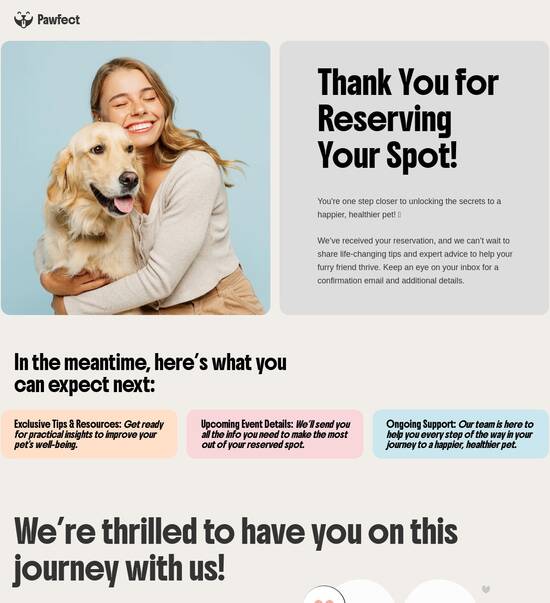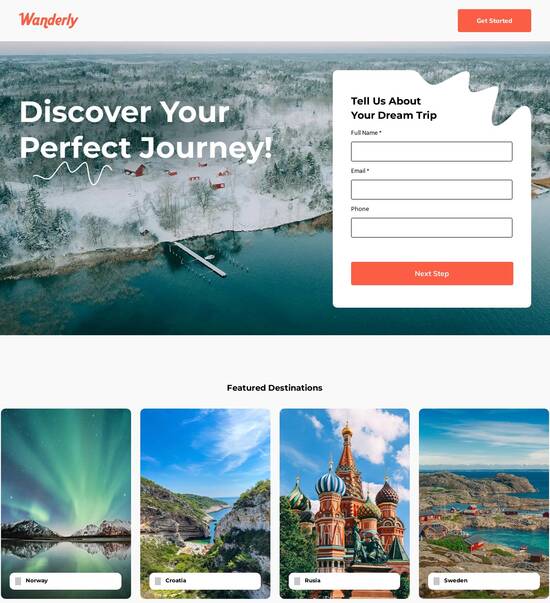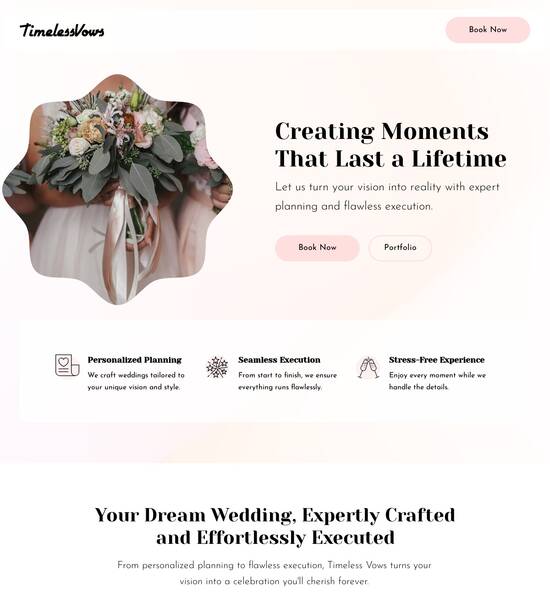
HTML page template for amusement parks
Use TemplateAbout template
Engage your audience like never before with stunning landing page templates for amusement parks. Make your online presence unforgettable!
Recommended templates

Easy to build without coding
With the intuitive drag-and-drop builder, anyone on your team can create high-converting pages without any knowledge of code or design. Make enhancements to your landing page with custom widgets using Javascript, HTML/CSS, or third-party scripts.

Multiple layouts for any industry and goal
Select from 500+ landing page layouts built to boost conversions across industry-specific scenarios. Customize them by adjusting fonts, adding images, and generating on-brand content with the AI assistant. Quickly scale with Instablocks® and Global Blocks that you can save, reuse, and update globally.

Loads fast and looks polished on any device
Every template is responsive, which means they present professionally on any device and load blazingly fast with our Thor Render Engine. You can also power them up with Google AMP technology to deliver an unparalleled mobile experience and drive higher conversions.

Robust analytics & experimentation
Get real-time updates and reporting across all your devices, showing the number of visitors, conversions, cost-per-visitor, and cost-per-lead. Launch AI-powered experiments, run A/B tests, and use heatmaps to analyze user behavior, then optimize your landing page to maximize conversions.







Easy to build without coding
With the intuitive drag-and-drop builder, anyone on your team can create high-converting pages without any knowledge of code or design. Make enhancements to your landing page with custom widgets using Javascript, HTML/CSS, or third-party scripts.
Multiple layouts for any industry and goal
Select from 500+ landing page layouts built to boost conversions across industry-specific scenarios. Customize them by adjusting fonts, adding images, and generating on-brand content with the AI assistant. Quickly scale with Instablocks® and Global Blocks that you can save, reuse, and update globally.
Loads fast and looks polished on any device
Every template is responsive, which means they present professionally on any device and load blazingly fast with our Thor Render Engine.
Robust analytics & experimentation
Get real-time updates and reporting across all your devices, showing the number of visitors, conversions, cost-per-visitor, and cost-per-lead. Launch AI-powered experiments, run A/B tests, and use heatmaps to analyze user behavior, then optimize your landing page to maximize conversions.
All the features you need to build amusement park template
Explore more featuresLearn how to build top-performing landing pages for any goal
FAQs
Leading the way in building high-performing landing pages





An effective landing page and CRO platform for American businesses
Leverage Instapage's powerful landing page capabilities to optimize the performance of your digital marketing campaigns. With features tailored to meet the diverse needs of industries like business services, education, and tech/SaaS, Instapage empowers marketers to create high-converting pages that are essential for driving ROI. This guide will walk you through the process of maximizing your marketing efforts with Instapage's unique offerings.
Getting started with Instapage's landing page builder
Creating a landing page on Instapage is a streamlined process. Start with their intuitive drag-and-drop builder which makes it accessible for teams of any skill level. Here are key steps to ensure an efficient creation process:
- Choose from over 100 high-converting templates to speed up your design process.
- Utilize Instablocks to easily insert advanced functionalities into your pages.
- Preview your landing page on multiple devices to ensure a seamless user experience.
Optimizing for conversions with built-in tools
Optimization is vital once your page is live. Instapage provides tools specifically designed to enhance performance. This involves:
- Using A/B testing to determine which elements convert better, enabling data-driven decisions.
- Analyzing heatmaps to gain insights into user behavior and adjust content accordingly.
- Regularly assessing your performance through detailed analytics to keep your goals aligned.
Personalizing user experiences
To truly engage visitors, deep personalization tactics can be employed. Leverage Instapage's features to tailor experiences that resonate with individual audiences:
- Implement dynamic text replacement to speak directly to segments of your audience.
- Use AdMaps to effectively align individual ads with tailored landing pages.
- Monitor audience-level metrics to refine strategies and enhance relevance.
By utilizing these features, you can create powerful marketing funnels that significantly enhance engagement.
Embrace Instapage's capabilities to advance your marketing endeavors and see measurable results.
Start creating impactful landing pages today and unlock the full potential of your digital marketing efforts.
People also ask about HTML page template for amusement parks
The Future of Online Engagement: HTML Page Template for Amusement Parks
Unleashing the power of HTML5 for amusement park websites
HTML5 has revolutionized the way websites are built and experienced, especially in dynamic sectors such as amusement parks. An HTML5 template builder is a tool that simplifies the process of creating visually appealing and functional web pages. It allows designers to utilize pre-built components that adhere to the latest web standards, streamlining the development process. By harnessing the capabilities of HTML5, amusement parks can achieve more interactive and engaging online presence.
The benefits of using HTML5 templates are manifold. They provide a structure for dynamic content, which means parks can update their attractions and events effortlessly. These templates can include interactive elements that draw user attention and facilitate seamless navigation. By catering to user needs, parks can boost their online visibility and enhance visitor engagement from the very first click.
Overview of key features for amusement park templates
When designing HTML page templates for amusement parks, several features stand out. Specialized layouts can be developed to cater to different attractions, be it roller coasters, water rides, or family-friendly activities. These layouts should be adaptable to showcase each attraction's unique selling points effectively.
Customizable sections for attraction details
Integration of multimedia elements like videos and image galleries
Responsive designs that work across devices
Including multimedia elements like high-quality images and immersive videos can greatly enhance visitor engagement. These features not only capture the essence of fun and excitement associated with amusement parks but also offer a glimpse of what awaits when they visit in person.
Crafting visually stunning pages with innovative design elements
Visual appeal is paramount in attracting visitors to amusement parks, and colors play an important role in achieving this. Color psychology suggests that specific colors evoke certain emotions, and amusement parks should leverage this by opting for vibrant hues that suggest excitement and playfulness. Bright yellows and reds are known to stimulate enthusiasm, while blues can evoke calmness. Choosing the right palette is essential to create an instant connection with potential visitors.
Equally important is the choice of fonts. Fonts not only represent a brand but also influence readability. For amusement parks, playful and fun fonts can enhance the playful theme while ensuring the text remains legible. When selecting fonts, it’s crucial to consider accessibility to ensure a diverse audience can easily engage with the content.
Structuring content for maximum impact
Content hierarchy is crucial for effective web design. Utilizing headers and subheaders thoughtfully can enhance SEO and improve user experience. The primary header should encapsulate the essence of the page, while subheaders can introduce sections that pique visitor interest. Engaging titles draw the eye and encourage deeper exploration of the site.
Implementing columns for content layout helps in organizing information clearly. This layout is particularly effective when featuring multiple park attractions. For instance, parks can utilize a two or three-column layout to display several rides concurrently, providing quick access to essential details without overwhelming users.
Use bold headers for attractions, events, and promotions
Engaging subheaders encouraging action and exploration
Multi-column formats for efficient showcasing of park offerings
Engaging multimedia: Including images and video content
Images have a powerful effect on online engagement. For amusement parks, leveraging high-quality visuals that capture the thrill of rides and attractions can create an immersive experience even before the visitor arrives. Selecting images that evoke excitement and joy can prompt potential guests to envision themselves enjoying these experiences.
Best practices for image optimization, such as compressing images without sacrificing quality, are vital for maintaining fast loading times. Slow-loading pages can lead to increased bounce rates. Videos also serve as excellent marketing tools. Promotional videos showcasing rides can create excitement, and judicious use of video backgrounds could capture attention while remaining aesthetically pleasing.
Select images that best represent park attractions
Optimize visuals for faster loading times
Utilize short, engaging videos to promote excitement
Implementing advanced functionalities for user experience
Load times can significantly affect user experience, and leveraging techniques like lazy loading can mitigate this issue. Lazy loading defers loading non-essential images until they become visible on the screen, improving initial load times. This technique is especially valuable for amusement parks that generally feature numerous images on their sites.
To ensure broad accessibility, ensuring functionality across various browsers and devices is critical. Cross-browser compatibility testing should be a routine part of the design process. Adopting modern coding practices helps maintain performance and visual integrity, regardless of how users choose to access the site.
Structuring the back-end for efficient data management
Understanding the Document Object Model (DOM) is essential for effective web development. The DOM represents the structure of a web page, enabling scripts to manipulate content and layouts dynamically. Optimizing templates to support a quicker response time upon loading can elevate user experience considerably and keep visitors engaged.
Common issues in template design include responsiveness and compatibility challenges. Being mindful of these factors during the design process ensures that the template will function seamlessly across devices. Designers should distinguish client-side concerns, which refer to the user's browser, from server-side issues, which impact how the content is served.
Focus on optimizing the DOM for quick rendering
Test templates for responsiveness across devices
Address both client-side and server-side issues proactively
Maximizing visitor engagement with interactive elements
One effective way to maximize visitor engagement is by implementing a dedicated download panel for brochures and tickets. This digital convenience eliminates the need for physical materials and allows potential visitors to explore park offerings at their own pace. The design should emphasize user-friendliness, ensuring that users can easily find what they need.
Additionally, incorporating call-to-action elements within the footer can provide ample opportunity for visitor interaction. Footers should contain essential navigation links, social media buttons, and actionable prompts that encourage visitors to deepen their exploration of park offerings.
Create a simple download panel for tickets and brochures
Include effective call-to-action elements in the footer
Utilize footers for social media engagement links
Holistic design strategy: Putting it all together
To create a cohesive layout for amusement park websites, all design elements must work together harmoniously. Balancing text, images, and interactive components is key to ensuring visitors remain focused and engaged. Designers should also remember the importance of whitespace, which can enhance visual flow and ensure each element stands out.
As technology continues to evolve, so will trends in amusement park web design. Looking ahead, integrating augmented reality (AR) and virtual reality (VR) technologies can allow visitors to explore rides and attractions virtually. This approach not only enhances online engagement but also sets the amusement park apart in an increasingly competitive market.
Case studies: Successful amusement park websites
Examining successful amusement park websites reveals innovative design strategies that capitalize on HTML5 templates. Many leading parks utilize visually striking layouts that draw users in, featuring detailed attraction pages, engaging visuals, and multimedia content. For instance, some parks integrate booking functionalities directly into their web images, enabling visitors to purchase tickets faster.
User feedback plays a critical role in ongoing website improvements. Gathering insights through user reviews can reveal which aspects resonate most with visitors and drive further redesigns. Personalization trends, informed by analytics, can steer future design decisions, leading parks to tailor their offerings specifically to visitor preferences.
Highlighting the top amusement parks utilizing cutting-edge designs
Learning from user feedback to drive improvements
Adapting personalization based on visitor analytics
Ready to skyrocket conversions?
Supercharge your ad campaigns with high-performing landing pages
Get started














